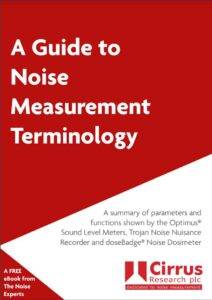Why Do You Need a Windshield on a Sound Level Meter?
A windshield is a very useful part of your noise measurement equipment and there are several reasons why you should use a windshield when you are making noise measurements.
- Reduce the effects of wind & air movement across the microphone
- Protect the microphone from damage
- Keep the microphone capsule clean
1. Reduce the effects of wind & air movement across the microphone
Microphone capsules are sensitive things that have been designed to react to changes in air pressure. These changes can be very, very small when the noise levels are down to 20dB or quite large when the noise levels are over 140dB.
Making a capsule that can be sensitive across all these different levels is a challenge and makes the microphones susceptible to wind.
When you are measuring outdoors, you should use a windshield to reduce, as much as possible without affecting the results, the effects of wind upon the measurements.
The windshield that is available for your sound level meter has been designed to allow the changes in air pressure from noise through whilst reducing the turbulence that wind can create.
If you don’t use a windshield, are you sure that you are measuring the noise you want and not the noise from wind hitting the microphone.
As an example, we made some quick and rough measurements using a 30cm desk fan and an optimus sound level meter. These are not very scientific measurements and were done as an example so please bear this in mind!
The optimus sound level meter was fixed to a tripod and the distance between the fan and the microphone was set at 0.5m.
After calibration, we made four measurements. We also made a background noise measurement to verify that the ambient noise levels without the fan running were consistent and more than 30dB below the noise of the fan.
The measurements were:
- No windshield with the instrument in front of the fan
- No windshield with the instrument at 90 degrees to the fan (we tried this to see what the level of noise from the actual fan was)
- A standard 90mm windshield supplied with the optimus
- A high performance 90mm outdoor measurement windshield with a hydro-scopic coating
- Measurement 1 – 74.7dB(A) – Leq over 20 seconds
- Measurement 2 – 52.4dB(A) – Leq over 20 seconds
- Measurement 3 – 53.8dB(A) – Leq over 20 seconds
- Measurement 4 – 53.8dB(A) – Leq over 20 seconds
This is a very simple and crude set of measurements but it is clear that the two windshields reduce the noise levels from the fan by just over 20dB(A).
The noise measured without a windshield is a combination of the noise of the mechanics of the fan, such as the motor and the aerodynamic noise of the blades as they spin round, and the noise generated by the moving air hitting the microphone.
What we are interested in is the noise from the fan and not the noise of the air. By using a windshield we reduce the effects of the turbulence over the microphone.
The microphone capsule on your sound level meter is the most important part of the instrument. It’s the microphone that converts the changes in air pressure into an electrical signal. If this delicate part of your sound level meter is damaged in any way, your noise measurements could be incorrect.
Using a windshield can protect the microphone capsule from being knocked or banged when you are carrying the sound level meter around or when you are making measurements.
It’s always good practice to use a windshield even when you are measuring noise indoors as this can often be the place where you are likely to damage the microphone.
If you’re using your sound level meter on a tripod, again always use a windshield.
Don’t forget to remove the windshield before you calibrate your sound level meter. This may sound a bit obvious but we do get phone calls and emails asking how to calibrate the instrument with the windshield fitted.
3. Keep the microphone capsule clean
The moving parts of a microphone capsule are very delicate and very light in weight. Any contamination of the thin microphone diaphragm*,such as drops of water or dirt, can affect the way in which the microphone and the sound level meter measure noise.
Using a windshield for all noise measurements helps to keep these potential contaminants away from the delicate bits and keeps your microphone measuring accurately and as intended when it was designed.
Most microphones that are used on sound level meters use a protective grill above the diaphragm and this helps to prevent damage but using a windshield gives more protection.
*The diaphragm is the thin, light skin at the top of the microphone that moves with changes in air pressure.
Any questions?
If you have any questions about using your sound level meter or if there are any other questions that you have about noise measurement, just let us know. Fill in the form at the top right of this page and we’ll get back to you.
Stay up to date with new posts and information
You can also get details of our noise measurement instruments and keep up to date with new posts by signing up for our news feed. Enter your email into the Stay Informed box and pres Subscribe. When there’s a new post on our blog, you’ll get an email delivered direct to your inbox.
Jaymee-lee Tolliday
Latest posts by Jaymee-lee Tolliday (see all)
- Turning Down the Volume: How the Trojan Noise Nuisance Recorder can help create a quieter world - 13th February 2024
- Festive Opening Hours 2023 - 6th December 2023
- Award of Excellence for Cloud-Based Monitoring Solutions 2023! - 20th November 2023

